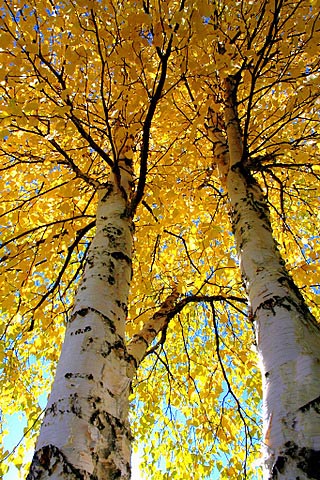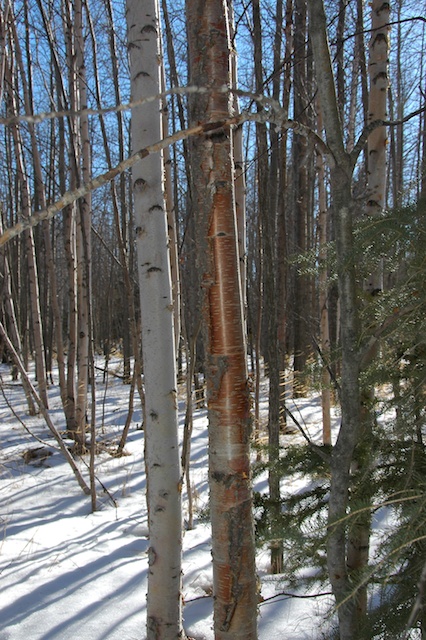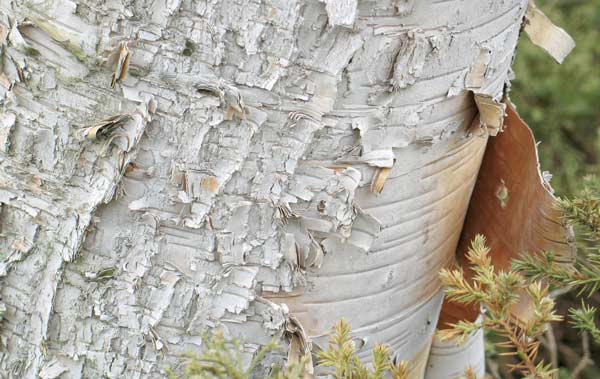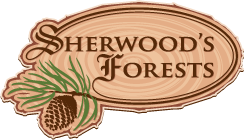Native Birch -- Paper, River, Bog
Betula paperifera

Paper Birch in Fall Colour
We have at least three birches here in Alberta. Paper or Canoe birch is the best known. But there is River Birch (B. occidentalis) and Dwarf or Bog birch (B. glandulosa) River or Water birch has darker bark ranging from salmon to bakers chocolate with russet notes. Some day we will carry it. Dwarf birch is a bog loving shrub about that gets 4 to 7 feet tall. with leaves the size of your thumbnail. It also is common in subalpine meadows. I can get this as plug stock. Ask no later than early fall (July is better) for the following spring.
Paper Birch
Paper birch is the star of the show.
Sometimes known as Canoe Birch or Silver Birch. This is the tree that created Canada; that allowed the Hudson Bay and Northwest Fur companies to cross a continent. The bark is fairly smooth, is waterproof, and can be stripped from the tree in massive sheets. (This kills the tree.)
In addition to canoe covering, natives used the wood for framing the canoe and for making snowshoe frames.
The bark can be almost pure white, with dark horizontal ovals (lenticels) In a forest, the white bark seems almost luminous. More common is a silvery grey.
Twigs are chocolate brown when young. Bark will have it's characteristic white peely look by the time the branch is one to two inches thick.
Plant paper birch:
- If you want go native.
- You have a low area that is squishy late in spring, and after any hard rain
- Wildlife enhancement: Pollen for bees in spring, winter feed for chickadees and redpolls.
- Want winter interest.
Features
- Very white to ivory bark, sometimes redish or purple-brown when young, with attractive peels. Twigs are fine textured chocolate brown.
- Leaves are diamond shaped, with toothed edges.
- For a few weeks in fall the leaves are a golden pure yellow. Holds leaves fairly late.
- Open crown allows grass to grow underneath.
- Resistant to Bronze Birch Borer
Growth
- Two to three feet per year when young.
- Mature height can be up to 70 feet, and 3 feet across at the stump. This size is uncommon on the prairie unless ideally sited. 30 to 40 feet tall by 16 inch diameter is more typical.
- Short lived -- 40 to 70 years typical. 200 years maximum.
- Full sun preferred. Tolerates 50% shade. Growth rate is slower in shade.
- Prefers consistently moist loamy soils. Will grow on sandy soils if water table is close to surface.
- Tolerates short term flooding

Birch trees add winter interest to a landscape. Bark color is variable when young. Most trees start out reddish brown, and start going white when they are 1 to 1.5" thick. Here we have an example of one desperately holding on to it's youth.
Ideas for the Landscape
Plant 3 or 5 in a fairly tight clump. Angle them slightly apart. Or buy a clump form birch from me to start.
Plant a birch by a pond where it will reflect.
Plant a row of birch by your driveway, put them 25 feet apart, and set the row back far enough to allow for the snowblower to pile snow at the base (15 feet from edge of driveway) Plant a row of spruce behind them on half the spacing. Put two dogwoods, or a crabapple between each birch. This will give you year round interest.

The peeling bark ads some winter interest. The curls are also winter homes to various bugs.
Paper birch hybridizes with nearly all other members of the birch genus. You will see variation in shape, bark colour, leaf shape. Even the chromosome count can vary in seeds from the same tree.
I've been told that birch in the wild only grow where there is an underground stream or seep, or a high water table. Not being a mole, I've not had an opportunity to check this out, but it fits my above ground observations.
Dwarf Birch
Betula pumila to the botanists, dwarf birch is also known as bog birch or swamp birch. Bet it likes water, eh? Anyway, in 2017 I have 180 coming in as seedlings for the adventurous among you.

This is not a tree, but a shrub. In good conditions it can get 9-12 feet tall. My encounters with say half that or less most of the time.
Dwarf birch is a common alpine species, and if you backpack it and a few willows are the ‘pucky brush’ in subalpine meadows from tree line to rock line. Leaves are small, about the size of a nickle, with round teeth on the edge, compared to the sawtooth of paper birch.
Inventory for native birch in the main Birch & Kin page.
Got something to say? Email me: sfinfo@sherwoods-forests.com
Interesting? Share this page.
Want to talk right now? Call me: (8 am to 8 pm only, please) 1-780-848-2548
Do not arrive unannounced. Phone for an appointment. Why? See Contact & Hours That same page gives our hours of operation.
Back to Top
Copyright © 2008 - 2021 S. G. Botsford
Sherwood's Forests is located about 75 km southwest of Edmonton, Alberta. Please refer to the map on our Contact page for directions.
